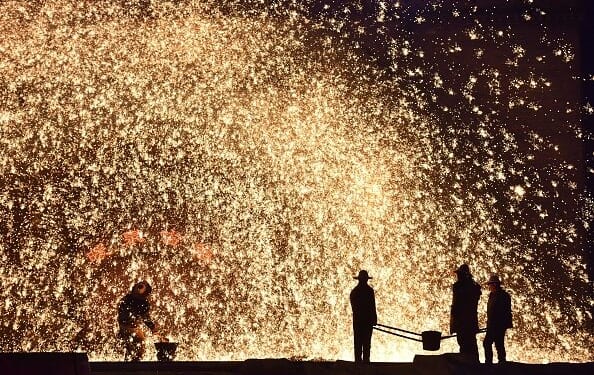When it opened last month, the Huajiang Grand Canyon Bridge wasn’t just a marvel of engineering. Rather, it became a symbol of how different China and the US have now become. Soaring 625 metres above the wooded hills of southern China, and now the world’s highest bridge, it felt a universe away from the crumbling subways and collapsing bridges that now pass for basic infrastructure in the Land of the Free.
In fact, argues Dan Wang in his first book, Breakneck: China’s Quest to Engineer the Future, the two political rivals are very similar. Pragmatism, crude materialism, a can-do attitude, fascination with the technological sublime, and elites distrustful of “the people” — all these examples bring them closer than we think. And yet, after spending years exploring China’s technological rise, Wang argues that one key difference nonetheless separates the two nations. While the highest offices in the Chinese Communist Party (CCP) are staffed with engineers, Washington is the capital of a lawyerly society — a distinction that could yet decide our century.
According to Breakneck, the rise of America’s lawyers begins in the Sixties. This narrative can be anchored in data. As Jonathan Rauch notes in The Growth of the Parasite Economy, the proportion of lawyers in the general population remained stable from 1870 to 1970. Then it doubled. This is precisely the period when, according to thinkers as varied as Tyler Cowen and Peter Thiel, the “great stagnation” begins: an erosion of America’s productive forces that set the stage for a retreat into virtual worlds and a narrowing of technological progress to advances in software.
A lawyerly society excels at obstruction. The dynamism seen in China is impossible in America’s vetocracy, which is bent on blocking any new innovation. Yet if the US lawyered itself into stagnation, China grew at breakneck speed. Since the Eighties alone, it has built the equivalent of two American highway systems. Its high-speed rail network is 20 times larger than Japan’s. Shanghai, where Wang spent most of his time in China, added between 2003 and 2013 as many subway tracks as the entire New York City system. This relentless pace is hard to imagine for Westerners. “When my parents emigrated,” Wang explains, “China’s economy was growing above 10% a year. If they had stayed in [their home town of] Kunming, they would have felt like they were living in a new city roughly every seven years — that’s how long it takes for the economy to double”.
The dominance of lawyers also shapes how the US conducts its relations with China. The so-called tech trade war didn’t take the form of export controls out of nowhere. Rather, Wang explains that “America reacted to China’s technological rise with a series of legalisms” — from tariffs and export controls to “investment restrictions from previously sleepy offices deep in the bowels” of government. This lawyerly approach had unintended consequences.
For if it cut China’s leading tech firms off from their American chip suppliers, it ultimately encouraged self-sufficiency. “Beijing has long crowed about achieving technological self-sufficiency,” Wang tells me. “For the most part, Chinese companies had brushed off these enjoinders: after Trump, they grew more committed to self-sufficiency to save their own operations.” Washington went all in on a legalistic trade war, while Xi doubled down on filling the Politburo with engineers. In the end, the effects of this legalistic offensive on China’s technological momentum were questionable — if not the very opposite of what was intended.
According to Wang, meanwhile, concentrating the fire of sanctions on cutting-edge chips is misguided. This is a rare view in the United States, where what remains of economic dynamism flows downstream from data centres. But as Wang warns, the idea that progress in AI will translate into decisive advantage on the geopolitical chessboard isn’t necessarily true. “Beijing is always pursuing a portfolio approach to technological competition,” he explains. “They never target a single technology or industry. Made in China 2025 targeted 10 major industrial segments. While they catch up on AI, they are also doing everything that includes industrial robotics, advanced electronics, unmanned vehicles, and everything else that might be useful for warfare.”
Though the American establishment tries to convince itself that nothing is more important than achieving AGI before China does, in other words, Wang suggests that, from Beijing’s perspective, this race is only a sideshow — especially as “America’s weaknesses in manufacturing continue to deepen”. One is almost tempted to go further: Trump’s reindustrialisation agenda is faltering precisely because investment pours into AI instead of manufacturing.
All the while, Wang argues that China’s engineer-minded elite consciously chose to reject “technology with American characteristics” — the “fictitious” economy of digital platforms and finance. What many commentators in the West assail Xi Jinping’s “tech crackdown”, then, the President himself interprets these actions as part of a contest between two models: the CCP’s effort to reorient the economy away from innovation in virtual and financial domains, and to ensure that the brightest students pursue engineering rather than careers in profitable but unproductive quant funds.
Despite all this, Wang remains an optimist about America’s ability to recalibrate. “There’s no reason that we cannot gradually increase the share of engineers or economists within the top ranks of the American government,” he says. “In fact, the share of lawyers in the US Congress has already steadily declined over the past century.” And even if there’s no way to escape the lawyers’ clutches, he nonetheless suggests that America’s legal culture can be shifted. When FDR ruled America, after all, lawyers were “dealmaker types” — ambitious radicals who built the Hoover Dam and rearmed for world war.
“Even if there’s no way to escape the lawyers’ clutches, America’s legal culture could nonetheless be shifted.”
And if the US needs to correct course, the Chinese engineering state is not without flaws. In the Seventies, when an influential CCP rocket scientist returned from the West, he carried with him the blight of environmental doomerism. Convinced that the population bomb could destroy China, he persuaded Communist leaders “that population trajectories could be as firmly controlled as missile trajectories”. This was the beginning of the one-child policy. Hundreds of thousands of forced abortions ensued, along millions more sterilisations.
Regional officials had their quotas and hitting them became the only thing that mattered: women were handcuffed and transported to clinics where the children were ripped from their bodies. “One-child policy and zero-Covid are the expected outcomes of an engineer-run state,” Wang says. “The engineers were terribly literal-minded when they allowed a missile scientist to help design population policy, and then to order mass abortions in order to stop families from having more than one child. There’s also a literal-mindedness when they prohibited people from leaving their homes in order to halt the transmission of a virus.”
I ask Wang if such monumental missteps could impact the long-expected invasion on Taiwan. “For the most part,” he responds, “the literal-mindedness has been a restraint against miscalculations abroad. It is fully fair to say that Beijing has displayed little bellicosity for nearly the entirety of the past five decades. Xi in particular has displayed a considerable degree of strategic patience as well as a willingness to beat the occasional tactical retreat. So I expect that Beijing’s interventions will deliver greater suffering to its own people than to others”.
Over the years, we’ve heard much of China’s coming collapse. The narratives change, but the prognosis remains the same. Whether it’s the demographic slowdown, the crisis in the real estate sector, or, lately, industrial overcapacity, the commentariat’s pessimism may actually make Western leaders less alert to the scale of the challenge. Wang, for his part, is clear: Chinese technological momentum is unstoppable, and trade restrictions cannot halt it, as its industrial ecosystem is just too vast and displays extraordinary ability to adapt. The UN projects that within five years, 45% of the world’s industrial capacity will be concentrated in the People’s Republic.
Yet if China looks unassailable from without, there is something rotten in the state of Xi. The phenomenon of “rùn” — moving out of China to escape the unpredictability of the CCP — is an unmistakable sign of malaise. Some view this trend as limited to a particular slice of the millennial generation in major cities, squeezed by tanking real estate values and the influx of Gen Zers into the job market. Wang disagrees. “There are three groups of Chinese who have been obviously disgruntled by the regime over the past few years”, he says. The first are the wealthy, who resent having their businesses “smashed” and their properties devalued. Considering thousands of millionaires may have left the country in 2022 alone, it’s a fair point.
The second unhappy tranche, Wang continues, are “creative types” — “who have seen their art or journalism strangled by the censors, and who are hanging out in Thailand smoking dope.” But perhaps the most telling group are those Chinese willing to fly to Ecuador before crossing into the US on foot. “One of the most incredible facts,” Wang adds, “is that the United States was apprehending up to 40,000 Chinese nationals at its southwestern border in certain months in 2024”.
How, in the end, to explain this unhappiness — as purely a function of economics or the feeling that the “Chinese Dream” is being crushed by the inhuman hand of the engineering state? “It’s hard to say how the broader masses of people in China feel,” Wang responds. “But I think it is still striking that many Chinese wish to take leave of the great rejuvenation that is undertaken in their name.”
There’s an irony here. If China is so strong as some describe it, then there is no point in competing. Yet if it’s ridden with problems that will lead to inevitable collapse, then we can just sit back and watch events unfold. Both perspectives converge on apathy. One of Breakneck’s merits is Wang’s ability to lead us back to the narrow path of realism. Yes, engineering states may instil pride with its capacity to build, but their lawyerly rivals are less prone to cruel aberrations. The first drains creative impulses out of society, the second stimulates them.
Even so, there is one area where nuance is a luxury America can scarcely afford. Capacity to build is decisive on the battlefield, a place without room for lawyerly deliberation. In war, hardware matters more than software. Recent years starkly remind us of this truth. The war in Ukraine exposed shortages in munitions production that would not allow the US to sustain a protracted conflict. For a superpower that protects the oceans in the name of free trade, the collapse of shipbuilding is astonishing: in 2022, China had 1,500 ships under construction, while the Americans had only five. The America of “Freedom’s Forge” — when broad engineering competence enabled total industrial mobilisation to defeat both Nazi Germany and Imperial Japan — feels very distant now.
Still, Wang remains an optimist when it comes to America’s future. After all, China’s astonishing development is a reflection of strengths that America has lost, but may yet recover. He is far less sure about that third potential power: Europe. “On the one hand,” he says, “I see that China will deindustrialise Germany. China is moving into many of German industry’s core competences, especially in the automotive sector, and we can see that its exports to China have been shrinking. On the other hand, I expect that American companies in finance, services, and tech broadly speaking will outcompete their European counterparts as well.” As for the Europeans themselves, Wang suggests, they’ll be left hawking luxury goods to our century’s winners, whoever that turns out to be.

















